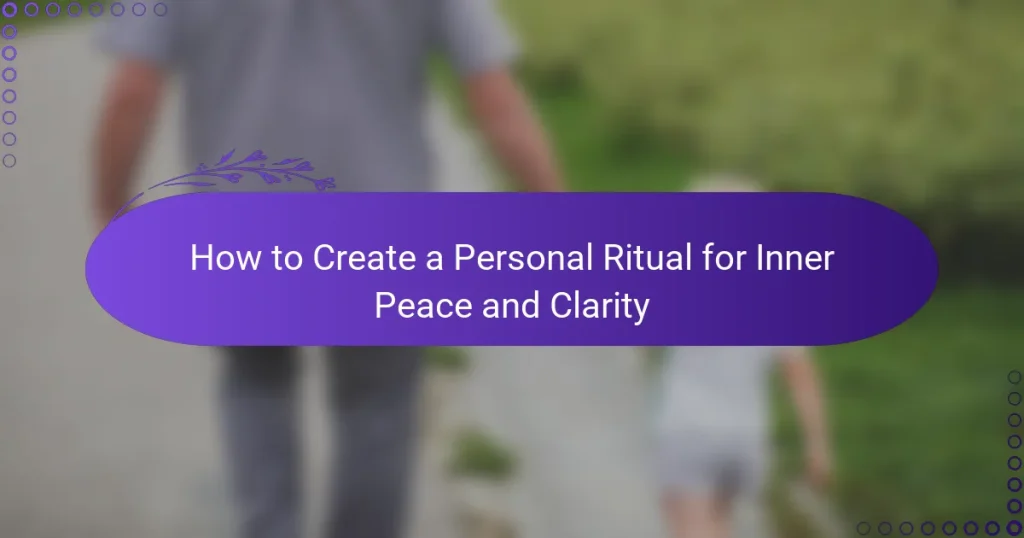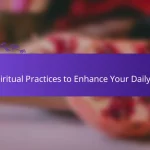Creating a personal ritual can be a transformative way to cultivate inner peace and clarity in your life. By intentionally setting aside time for practices that resonate with you, you can reduce stress and reconnect with your inner self. This guide will help you identify your goals and establish a routine that incorporates calming elements tailored to your unique preferences.

How can personal rituals enhance inner peace in urban environments?
Personal rituals can significantly enhance inner peace in urban settings by providing structured moments of calm amid the chaos. These practices help individuals reconnect with themselves, reduce stress, and foster clarity in their thoughts and emotions.
Mindfulness meditation
Mindfulness meditation involves focusing on the present moment, which can be particularly beneficial in bustling urban environments. By dedicating just a few minutes each day to this practice, individuals can cultivate a sense of calm and awareness, helping to alleviate anxiety and improve mental clarity.
To start, find a quiet space where you can sit comfortably. Close your eyes and focus on your breath, allowing thoughts to come and go without judgment. Aim for a duration of 5 to 15 minutes, gradually increasing as you become more comfortable with the practice.
Nature walks in city parks
Taking nature walks in city parks offers a refreshing escape from urban life, promoting inner peace through exposure to greenery and fresh air. These walks can help clear the mind and provide a sense of tranquility, making them an excellent addition to your daily routine.
Consider setting aside time each week to explore local parks. Aim for a walk of at least 30 minutes, focusing on the sights and sounds of nature around you. This practice not only enhances your mood but also encourages physical activity, which is beneficial for overall well-being.
Journaling practices
Journaling is a powerful tool for enhancing clarity and processing emotions, especially in fast-paced urban environments. By writing down thoughts and feelings, individuals can gain insights into their experiences and reduce mental clutter.
To implement journaling, set aside 10 to 20 minutes each day to write freely about your thoughts, experiences, or gratitude. You can use prompts or simply reflect on your day. This practice can help identify patterns in your emotions and foster a deeper understanding of yourself.
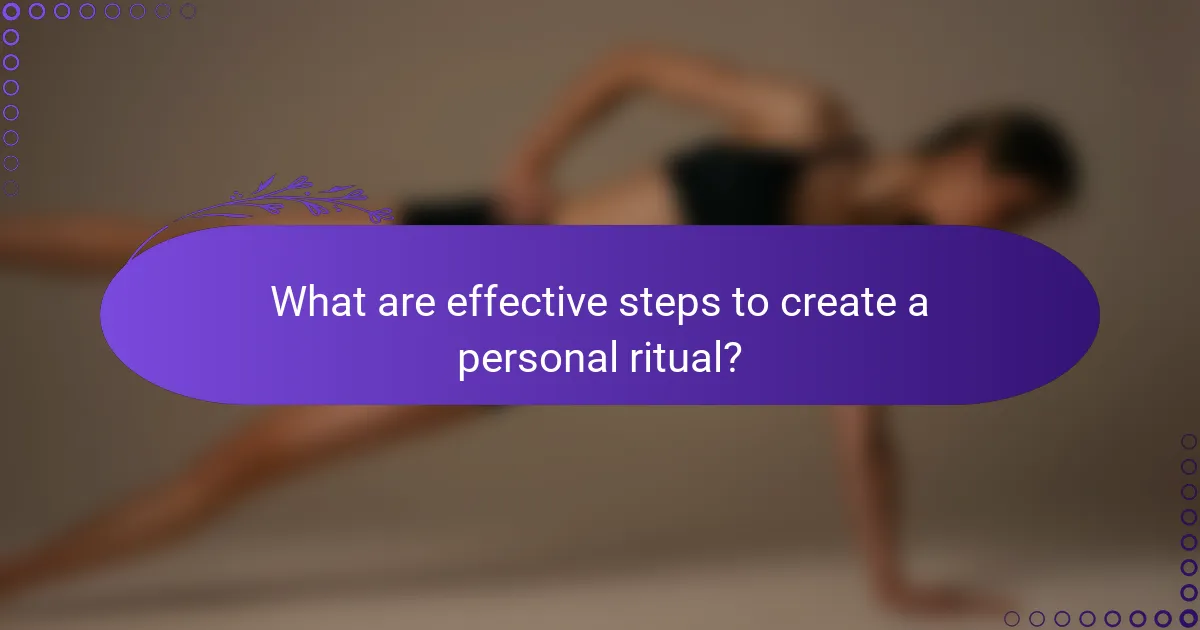
What are effective steps to create a personal ritual?
Creating a personal ritual involves intentional steps that foster inner peace and clarity. The process includes identifying your goals, establishing a routine, and integrating calming elements into your practice.
Identify your intentions
Start by clarifying what you want to achieve with your ritual. This could range from reducing stress to enhancing focus or cultivating gratitude. Write down your intentions to solidify your commitment.
Consider using specific, positive affirmations that resonate with your goals. For example, if your aim is to find calm, you might say, “I embrace tranquility in my life.” This helps reinforce your purpose each time you engage in your ritual.
Choose a consistent time
Selecting a regular time for your ritual is crucial for building a habit. Whether it’s early morning or before bedtime, consistency helps signal to your mind that it’s time to unwind and reflect.
Try to stick to the same time each day or week. This could be as short as 10 minutes or as long as an hour, depending on your schedule. The key is to make it a non-negotiable part of your routine.
Incorporate calming elements
Integrate elements that promote relaxation and focus into your ritual. This might include soft lighting, soothing music, or natural scents like lavender. These sensory cues can enhance your experience and deepen your sense of peace.
Consider creating a dedicated space for your ritual, free from distractions. This could be a corner of a room with comfortable seating, plants, or meaningful objects that inspire calmness and clarity.
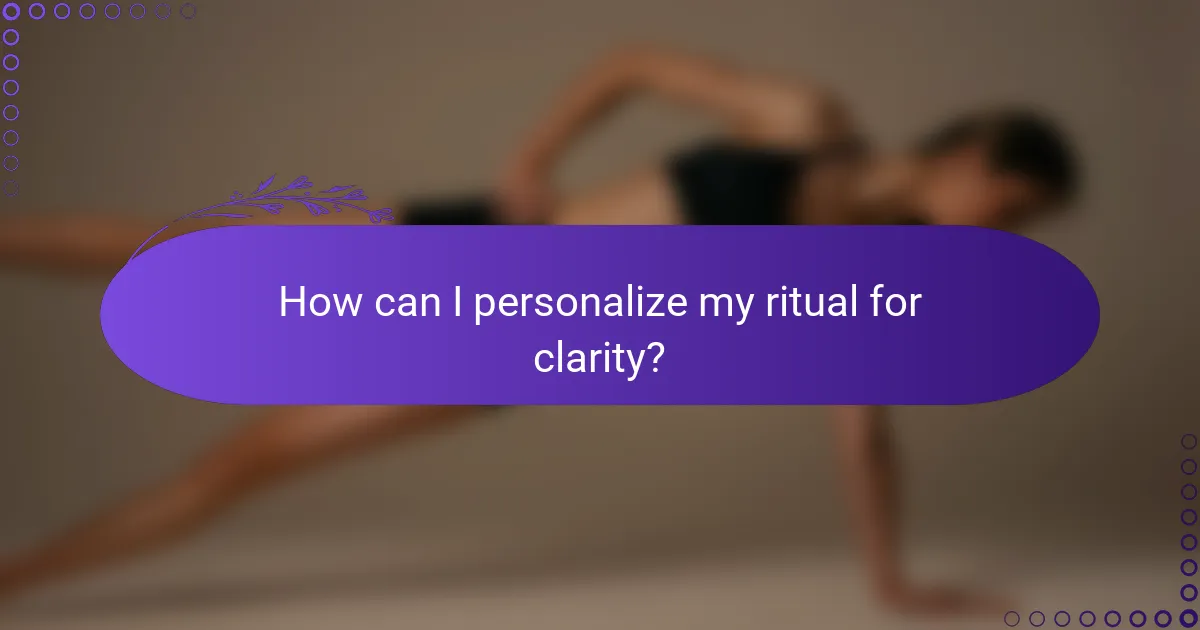
How can I personalize my ritual for clarity?
To personalize your ritual for clarity, focus on elements that resonate with you emotionally and spiritually. Tailoring your practice to include affirmations, scents, and sounds that you love will enhance its effectiveness and help you achieve a deeper sense of inner peace.
Use specific affirmations
Affirmations are positive statements that can help shift your mindset and promote clarity. Choose affirmations that reflect your goals and values, such as “I am calm and centered” or “I trust my intuition.” Repeat these phrases during your ritual to reinforce your intentions.
Consider writing your affirmations down and placing them in a visible spot during your practice. This can serve as a powerful reminder of your commitment to clarity and peace. Aim for 3-5 affirmations that resonate with you personally.
Incorporate favorite scents
Scents can evoke powerful emotional responses and enhance your ritual. Select fragrances that you find calming or uplifting, such as lavender, sandalwood, or citrus. Use essential oils, incense, or candles to introduce these scents into your space.
Experiment with different combinations to find what works best for you. For example, you might blend lavender with a hint of rosemary for a refreshing yet soothing aroma. Aim to create an environment that feels inviting and conducive to relaxation.
Integrate music or sound
Music and sound can significantly influence your mood and focus. Choose calming music, nature sounds, or even guided meditations that align with your intention for clarity. Create a playlist that you can use consistently during your rituals.
Consider using instruments like singing bowls or chimes to add an auditory element to your practice. The sound of these instruments can help ground you and enhance your sense of presence. Aim for sounds that resonate with you personally, as this will deepen your experience.

What tools can support my personal ritual?
Several tools can enhance your personal ritual for inner peace and clarity, helping you establish a consistent practice. Consider incorporating meditation apps, guided journals, and aromatherapy diffusers to create a supportive environment for your ritual.
Meditation apps like Headspace
Meditation apps, such as Headspace, provide structured sessions that guide users through mindfulness practices. These apps often include a variety of meditation styles, ranging from short five-minute sessions to longer, more immersive experiences.
When choosing a meditation app, look for features that resonate with your needs, such as themed courses, sleep aids, or even community support. Many apps offer free trials, allowing you to explore their offerings before committing to a subscription.
Guided journals
Guided journals can help you reflect on your thoughts and feelings, promoting clarity and self-awareness. These journals typically include prompts that encourage you to explore your emotions, set intentions, and track your progress over time.
To get started, select a journal that aligns with your goals, whether it’s gratitude, mindfulness, or personal growth. Aim to dedicate a few minutes each day to writing, as consistency can deepen your insights and enhance your ritual.
Aromatherapy diffusers
Aromatherapy diffusers can create a calming atmosphere that supports your personal ritual. By dispersing essential oils into the air, these devices can help reduce stress and promote relaxation, making it easier to focus during meditation or journaling.
When using a diffuser, choose essential oils known for their calming properties, such as lavender, chamomile, or sandalwood. Experiment with different blends to find what works best for you, and consider setting a specific time each day to incorporate aromatherapy into your routine.
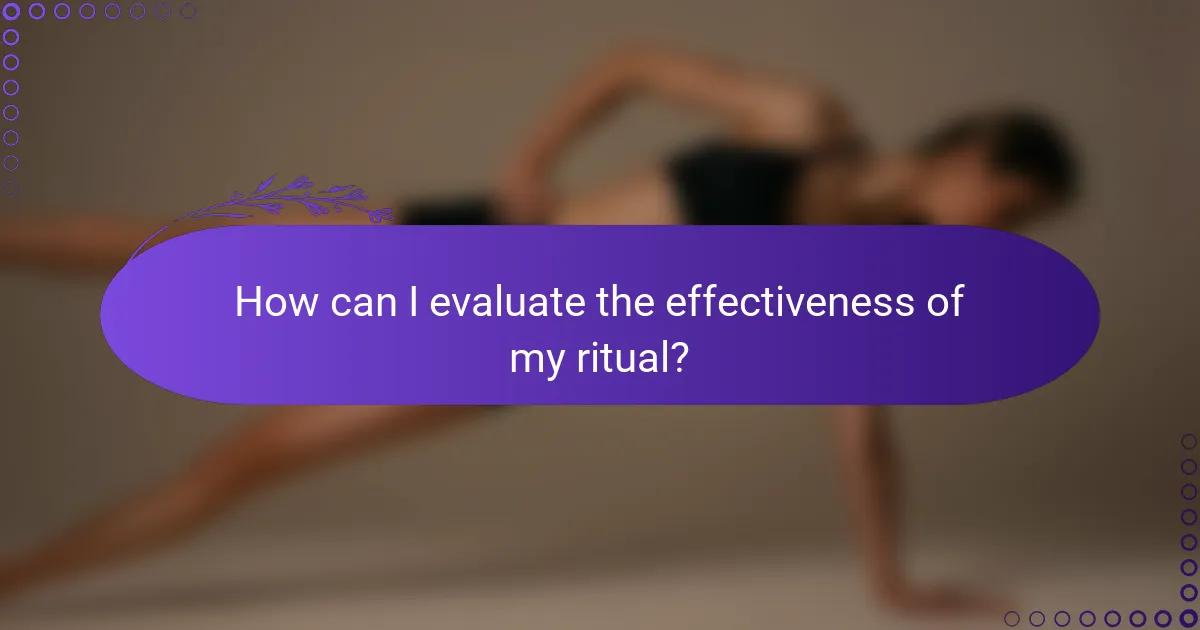
How can I evaluate the effectiveness of my ritual?
Evaluating the effectiveness of your personal ritual involves observing emotional shifts and assessing personal growth over time. By tracking these changes and setting clear goals, you can determine how well your ritual contributes to inner peace and clarity.
Track emotional changes
Monitoring your emotional state before and after your ritual can provide insight into its effectiveness. Consider keeping a journal where you note your feelings on a scale from 1 to 10, both prior to engaging in your ritual and afterward. This simple practice can help you identify patterns and trends in your emotional well-being.
Look for consistent improvements or declines in your mood. If you notice a positive shift, it may indicate that your ritual is beneficial. Conversely, if your emotional state remains unchanged or worsens, it may be time to reassess your approach.
Set measurable goals
Establishing specific, measurable goals can help you evaluate the success of your ritual. For example, aim to reduce anxiety levels by a certain percentage or increase your daily moments of mindfulness. Setting these targets provides a clear benchmark to assess your progress.
Ensure your goals are realistic and achievable within a reasonable timeframe. Regularly review these goals to see if they need adjustment based on your experiences and outcomes. This flexibility can enhance your ritual’s effectiveness over time.
Reflect on personal growth
Take time to reflect on how your ritual has influenced your overall personal growth. Consider aspects such as improved focus, emotional resilience, or enhanced self-awareness. Regular reflection can deepen your understanding of the ritual’s impact on your life.
Engage in periodic reviews, perhaps monthly or quarterly, to evaluate your growth. Ask yourself what changes you’ve noticed and how they relate to your ritual. This reflective practice can help you appreciate the benefits and motivate you to continue your journey toward inner peace and clarity.
